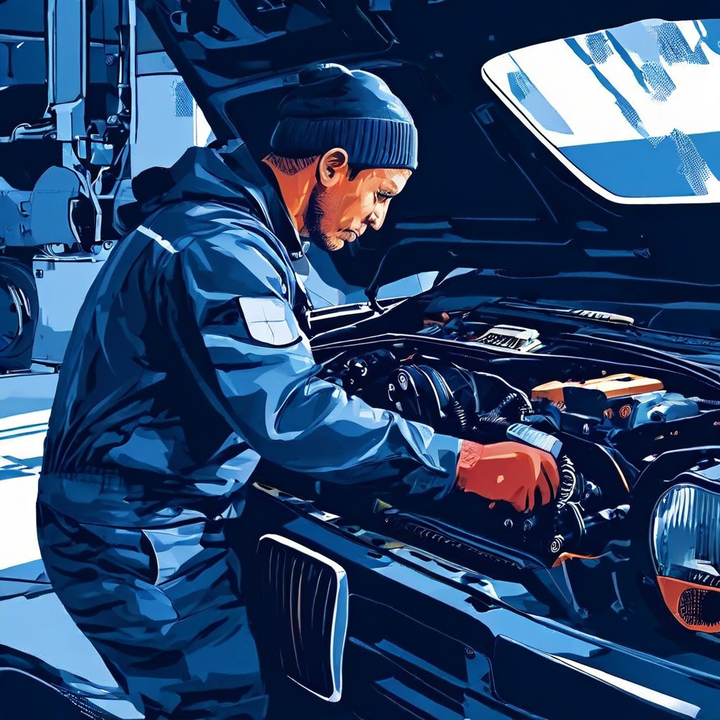


The "Engine Malfunction Reduced Power" warning is a common issue that can occur in various vehicle models. This warning message typically appears on the dashboard, indicating that the vehicle's engine control unit (ECU) has detected a problem and has intentionally limited the engine's power output to prevent further damage. This condition is often referred to as "limp mode" or "reduced power mode."
The reduced power mode is a safety feature designed to protect the engine from potential harm caused by a malfunction or issue within the engine's systems. When the ECU detects a problem, it activates this mode to restrict the engine's performance, such as limiting acceleration, top speed, and overall power output.

Over the years, I've identified several common culprits that can trigger the reduced engine power mode. Let's dive into some of the most frequent offenders:
One of the primary suspects is the fuel system. A faulty fuel pump, clogged fuel filter, or dirty/failing fuel injectors can restrict the fuel delivery to the engine, causing it to run lean and lose power. I've seen cases where a simple fuel filter replacement or injector cleaning has resolved the issue, restoring the engine's full potential.
The throttle body plays a crucial role in regulating airflow into the engine. A dirty or stuck throttle body, or issues with the throttle position sensor/actuator, can prevent the throttle from opening fully, limiting airflow and reducing power output. Cleaning the throttle body or replacing the faulty components can often resolve this problem.
A clogged or dirty air filter can severely restrict the air supply to the engine, resulting in a lean air/fuel mixture and reduced power. It's a simple fix, but one that can have a significant impact on performance. I always recommend checking and replacing the air filter as part of routine maintenance.
| Issue | Description |
|---|---|
| Faulty Sensors | Sensors like the mass airflow (MAF), accelerator pedal position, oxygen, or camshaft/crankshaft sensors can provide incorrect data to the engine computer, resulting in improper air/fuel mixture and reduced power. |
| Electrical System Issues | Loose connections, wiring problems, or grounding issues can disrupt communication between various engine components and the computer, causing reduced power mode. |
| Emissions System Faults | A clogged catalytic converter or malfunctioning EGR valve can increase backpressure and restrict exhaust flow, reducing engine power. |
| Overheating Engine | If the engine overheats due to coolant leaks or a failing cooling system, the computer may reduce power to prevent further damage. |
| Transmission Problems | Low fluid levels, faulty sensors, or control module issues can affect power transfer from the engine to the wheels, resulting in reduced power. |
When a customer brings in a vehicle with a reduced engine power warning, my first step is to connect it to an OBD-II scanner to retrieve any diagnostic trouble codes (DTCs). These codes can provide valuable insights into the specific system or component causing the issue.
From there, I follow a systematic approach to diagnose the root cause:
Visually inspect components like the throttle body, air filter, vacuum lines, and electrical connections for any issues.
Check for proper operation of sensors like the mass airflow sensor, throttle position sensor, and accelerator pedal position sensor.
Perform a fuel system pressure test to check for any leaks or restrictions.
Inspect the catalytic converter and exhaust system for any blockages or damage.
Check engine coolant levels and cooling system components for any leaks or malfunctions.
Verify transmission fluid levels and check for any transmission-related codes.

If the reduced power light comes on immediately after a cold start and goes away after the engine warms up, it could indicate a throttle body or sensor issue.
If the light comes on under heavy acceleration or high RPMs, it may point to a fuel system problem like faulty injectors or a clogged filter.
If the light is accompanied by misfires or rough idling, it could be related to ignition system components like spark plugs or coils.
If the light is triggered by high engine temperatures, it may indicate an overheating issue or a problem with the cooling system.
If transmission-related codes are present, it could be a sign of a transmission problem causing reduced power.
Once the root cause has been identified, it's time to address the issue. This may involve:
| Repair | Description |
|---|---|
| Throttle Body/Sensor Repairs | Clean the throttle body using an approved cleaner, and replace faulty throttle position sensors, accelerator pedal position sensors, or mass airflow sensors as needed. |
| Fuel System Repairs | Replace the fuel filter if clogged, replace a faulty fuel pump, and clean or replace faulty fuel injectors as required. |
| Electrical System Repairs | Check for loose connections and repair or replace any damaged wiring or connectors. Ensure proper grounding of all electrical components. |
| Emissions System Repairs | Replace a clogged or damaged catalytic converter, and repair or replace a malfunctioning EGR valve. |
| Cooling System Repairs | Check for coolant leaks and replace any damaged hoses or components. Ensure proper operation of the cooling fan and thermostat. |
| Transmission Repairs | Top up or replace the transmission fluid if low or contaminated, and replace any faulty transmission sensors or control modules as needed. |
Always use high-quality replacement parts from reputable manufacturers.
Follow the manufacturer's repair procedures and torque specifications carefully.
Clear any stored diagnostic codes after repairs and perform a road test to ensure the issue is resolved.
Follow the recommended maintenance schedule for your vehicle, including regular oil changes, air filter replacements, and fluid level checks.
Use high-quality fuel and avoid running the tank too low, which can introduce contaminants into the fuel system.
Avoid excessive idling or high-load driving conditions that can cause overheating.
Address any issues promptly to prevent further damage and more costly repairs.
The cost to fix an engine with reduced power can vary significantly depending on the underlying cause. Here are some estimated costs:
Replacing a spark plug: $3-$20 per plug
Cleaning a mass airflow sensor: $40-$100
Replacing a throttle body: $200-$500
Replacing a fuel pump: $300-$1,000 (including labor)
Replacing a catalytic converter: $500-$2,000 (including labor)
Transmission repairs: Costs can range from a few hundred dollars for minor issues to several thousand dollars for major repairs or replacements.
It's important to note that these costs can vary based on the make and model of the vehicle, the specific repair required, and the labor rates in your area. Additionally, some repairs may be covered under the vehicle's warranty, which can significantly reduce the out-of-pocket expenses.
The "Engine Malfunction Reduced Power" warning can be a frustrating experience for any driver, but with the right knowledge and approach, it's a problem that can be resolved. As a mechanic, I've seen countless cases where a thorough diagnosis and proper repairs have restored vehicles to their full potential.
Remember, preventive maintenance and addressing issues promptly are key to avoiding reduced engine power and keeping your vehicle running smoothly for years to come. If you ever encounter this warning, don't hesitate to bring your vehicle to a trusted mechanic for a professional diagnosis and repair.
Happy motoring!
Fuel contamination, typically water in the fuel, is the most common cause of engine failure after take-off. Mechanical failure is statistically the least likely cause.
Carburettor icing can restrict the air supply to the engine, leading to a rough running engine or complete failure. Applying carburettor heat can help resolve this issue.
Ensure that carburettor heat is selected to COLD before opening the throttle for take-off to avoid introducing dust or debris into the carburettor.
A blocked air filter can obstruct the air supply to the carburettor, leading to engine failure. Selecting carburettor heat, which bypasses the air filter, can provide an alternate air source.
Fuel starvation occurs when there is fuel on board, but it's not reaching the engine due to issues like a mispositioned fuel selector or blocked fuel lines. Proper fuel management procedures can help avoid this.
Fuel starvation occurs when fuel is present but not reaching the engine, while fuel exhaustion happens when there is no usable fuel on board, often due to poor flight planning.
During take-off, the engine is working at its hardest, increasing the risk of mechanical failure, although it is still the least likely cause of engine failure after take-off.
If anything appears abnormal during the take-off roll, including unusual sounds or obstructions on the runway, the take-off should be aborted by closing the throttle and braking as required.
The overriding priority in case of an engine failure after take-off is to fly the aircraft (Aviate), followed by navigating (Navigate) and communicating (Communicate) if time permits.
Prioritizing communication over flying the aircraft in an emergency situation can be dangerous, as the pilot's first responsibility is to maintain control of the aircraft before addressing other tasks.

Sarah isn't your average gearhead. With a double major in Mechanical Engineering and Automotive Technology, she dived straight into the world of car repair. After 15 years of turning wrenches at dealerships and independent shops, Sarah joined MICDOT to share her expertise and passion for making cars run like new. Her in-depth knowledge and knack for explaining complex issues in simple terms make her a valuable asset to our team.











